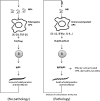Induction of immunoglobulin G4 in human filariasis: an indicator of immunoregulation
- PMID: 20863434
- PMCID: PMC3065634
- DOI: 10.1179/136485910X12786389891407
Induction of immunoglobulin G4 in human filariasis: an indicator of immunoregulation
Abstract
Filarial parasites are known to induce a large range of immunoregulatory mechanisms, including the induction of alternatively activated macrophages and regulatory T cells. These mechanisms are used to evade and down-modulate the host's immune system, to support parasite survival. Several reports have focused on some of these mechanisms, in humans and murine models, but the complex immunoregulatory networks associated with filarial infections remain unclear. Recent publications have conferred a role for regulatory T cells in the ability of helminth parasites to modulate human immune responses, such cells promoting the induction of the non-complement-fixing immunoglobulin G4 (IgG4). High plasma concentrations of IgG4 have been reported in hypo-responsive and asymptomatic cases of helminth infection. In both human lymphatic filariasis and onchocerciasis, the asymptomatic infections are characterised by high plasma concentrations of IgG4 (compared with those of IgE) and of the complement-fixing antibodies IgG1, IgG2 and IgG3. In asymptomatic filarial infection, elevations in IgG4 are also often associated with high worm loads and with high plasma levels of the immunomodulatory interleukin-10. Here, various aspects of the induction of IgG4 in humans and it roles in the immunomodulation of the human responses to filarial parasites are reviewed.
Figures

References
-
- Aalberse R. C., Stapel S. O., Schuurman J., Rispens T. Immunoglobulin G4: an odd antibody. Clinical and Experimental Allergy. 2009;39:469–477. - PubMed
-
- Agbolade M., Akinboye D. O. Loa loa and Mansonella perstans infections in Ijebu north, western Nigeria: a parasitological study. Japanese Journal of Infectious Diseases. 2001;54:108–110. - PubMed
-
- Akdis M., Blaser K., Akdis C. A. T regulatory cells in allergy: novel concepts in the pathogenesis, prevention, and treatment of allergic diseases. Journal of Allergy and Clinical Immunology. 2005;116:961–969. - PubMed
-
- Akdis M., Blaser K., Akdis C. A. T regulatory cells in allergy. Chemical Immunology and Allergy. 2006;91:159–173. - PubMed
-
- Akue J. P., Egwang T. G., Devaney E. High levels of parasite‐specific IgG4 in the absence of microfilaremia in Loa loa infection. Tropical Medicine and Parasitology. 1994;45:248246. - PubMed
Publication types
MeSH terms
Substances
LinkOut - more resources
Full Text Sources
